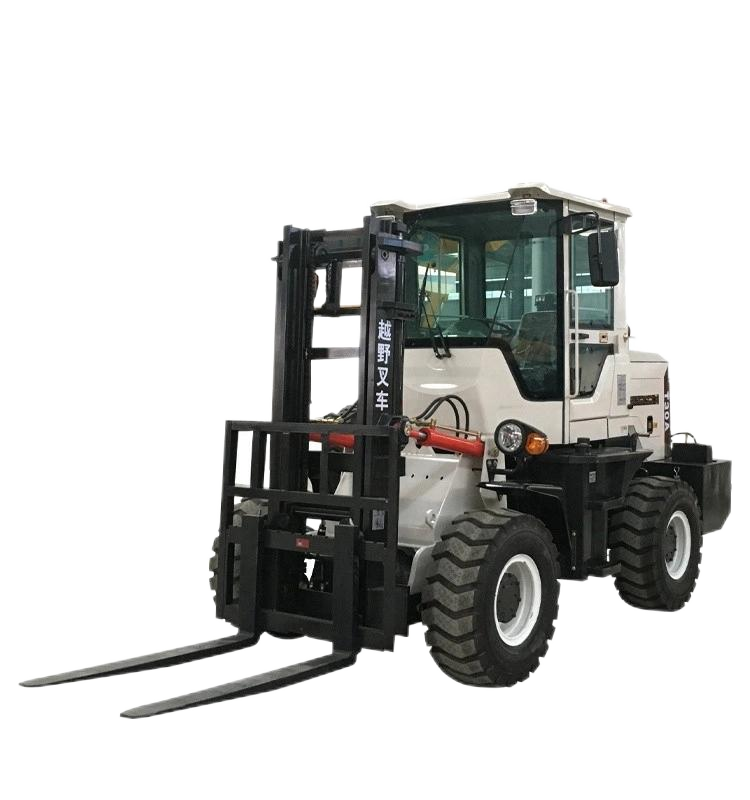Off-road forklifts can usually be classified in the following ways:

Classification by Power Source
Internal Combustion Off-road Forklifts: They use internal combustion engines as the power source, and common ones are diesel engines and gasoline engines. Diesel engines have high power, large torque, and good fuel economy, making them suitable for long-term and high-intensity operations. They are widely used in environments such as field projects and mines. Gasoline engines, on the other hand, have the characteristics of quick starting, smooth operation, and relatively low noise, and are suitable for places with relatively high requirements for noise and emissions.
Electric Off-road Forklifts: They use storage batteries as the power source and are driven by electric motors. Their advantages include no pollution, low noise, and low maintenance costs, making them suitable for places with high environmental requirements, such as indoor warehouses, food factories, and pharmaceutical factories. However, electric off-road forklifts have limited battery life, long charging times, and high battery costs.
Liquefied Petroleum Gas (LPG) Off-road Forklifts: They use liquefied petroleum gas as fuel and combine the power performance of internal combustion forklifts with some environmental protection features of electric forklifts. They have relatively clean emissions, low noise, high combustion efficiency, and stable energy output, and are suitable for some places that have certain environmental requirements but also need strong power.
Classification by Lifting Capacity
Small Off-road Forklifts: The lifting capacity is generally between 1 and 3 tons. They are compact, flexible, and easy to operate, and are suitable for places with limited space or the handling of light loads, such as small warehouses and the interiors of workshops.
Medium-sized Off-road Forklifts: The lifting capacity is between 3 and 10 tons. They are a widely used type of off-road forklift, capable of meeting the loading, unloading, and handling requirements of most conventional goods, and can be used in places such as construction sites, logistics centers, and port terminals.
Large Off-road Forklifts: The lifting capacity is above 10 tons. They are mainly used for the handling and loading/unloading of large goods, such as large equipment, steel, and timber, and are commonly found in large industrial places such as mines, steel plants, and heavy machinery factories.
Classification by Gantry Type
Standard Gantry Off-road Forklifts: The gantry structure is relatively simple, usually consisting of two columns and a crossbeam, with high rigidity and stability, and is suitable for most conventional cargo loading, unloading, and stacking operations.
Forward-moving Gantry Off-road Forklifts: The gantry can move forward a certain distance, allowing the forks to get closer to the goods, making loading and unloading and handling easier. At the same time, it can also improve the stability and operation safety of the forklift to a certain extent, and is commonly used in indoor warehouses or places with high requirements for the stacking position of goods.
Multi-stage Gantry Off-road Forklifts: The gantry is composed of multiple telescopic sections, which can achieve a relatively high lifting height, and is suitable for places where goods need to be stacked at a relatively high position, such as three-dimensional warehouses and multi-layer rack warehouses.
Classification by Drive Mode
Two-wheel Drive Off-road Forklifts: Generally, they are rear-wheel drive, with a simple structure and low cost, and are suitable for working environments with relatively flat terrain and light loads. They have flexible steering and are easy to operate, but their passability and traction are relatively weak on complex terrains or slippery roads.
Four-wheel Drive Off-road Forklifts: All four wheels can provide driving force, with stronger traction and passability, and can adapt to various complex terrains, such as rugged mountain roads and muddy roads. They perform better in terms of off-road performance and load capacity and are suitable for harsh working environments such as field projects and mining operations.
All-wheel Drive Off-road Forklifts: In addition to four-wheel drive, some off-road forklifts also adopt all-wheel steering technology, which gives the vehicle better maneuverability and steering flexibility in narrow spaces, and can perform special movements such as in-situ turning and crab walking, and is suitable for working places with narrow spaces and complex terrains.





